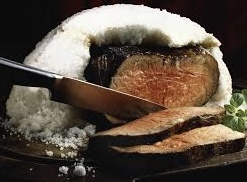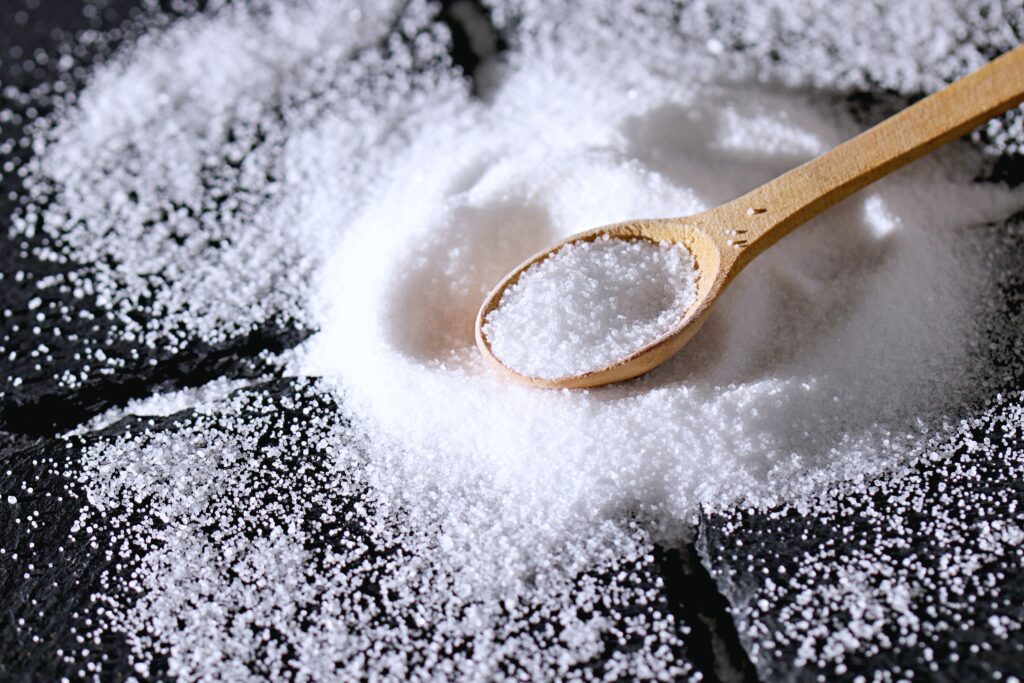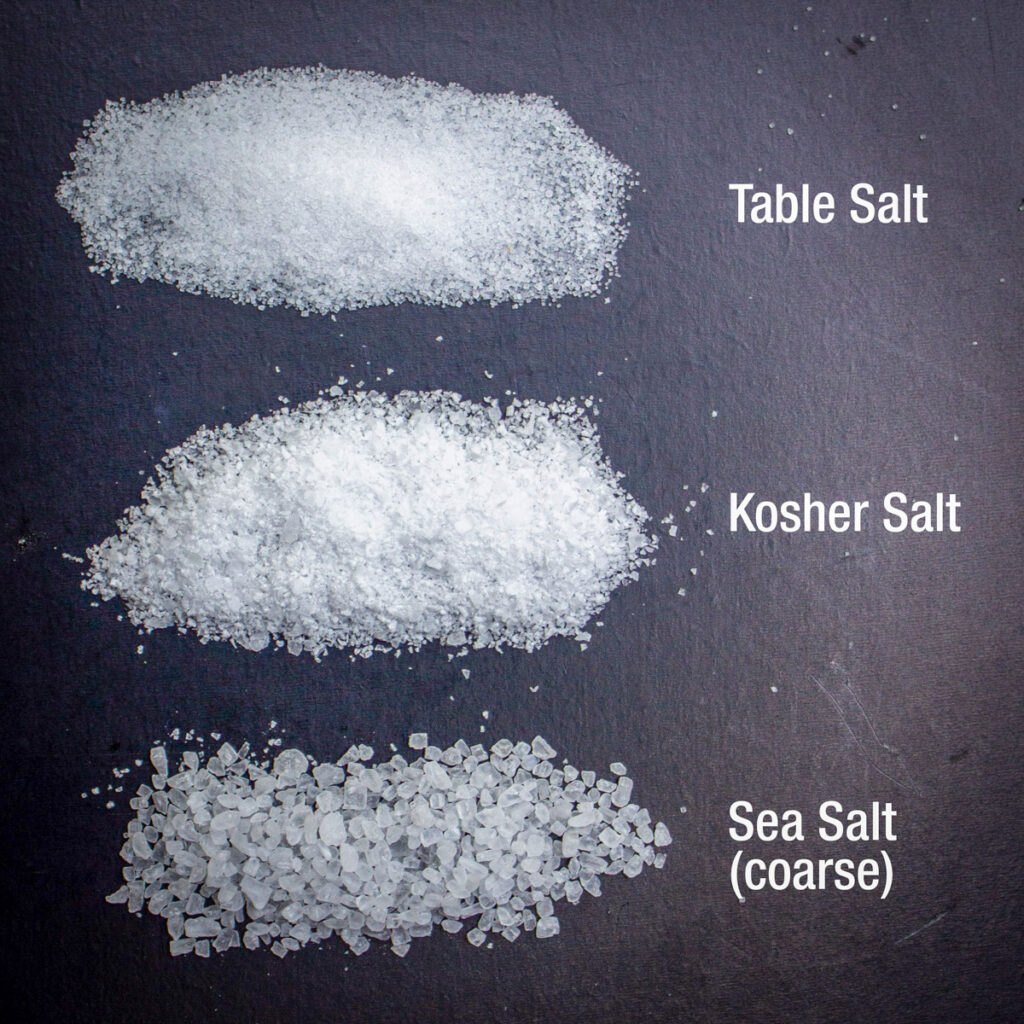
You just have to try this recipe to believe it! 😊 This method of cooking meat, caked in salt and then carefully grilled, produces the juiciest steak ever — and the meat does not absorb the salt! Moisture is sealed in by the salt crystal barrier, which also protects the meat from the extreme heat of hot coals or gas burners. Kosher salt works well for this recipe (and is much less expensive than sea salt, which also works.)Table salt is too finely grained for this use (and it is also often iodized, which could also add an “off” flavor to the meat).
2 cups kosher salt
2 New York steaks (or your favorite cut ) — about 1 inch thick
Preheat the grill. Mix salt with just enough water (about 3/4 cup) to make a non-runny paste. Firmly pack the salt paste onto the top of the steak. Place steak on the grill, salt side up, and cook until the salt begins to turn brown. Very carefully turn the steak over, and pack salt paste onto the other side. If some salt falls off, no worries — there is no need to replace it. Cook the steak as you would normally do to your desired doneness. Test it with a meat thermometer (since you cannot “feel” the steak for doneness). In about 8-10 minutes or so “Rare” doneness (125°) should be reached — “Medium” (130°) should take about 10-12 minutes, and “Medium-well” (160°) about 12-14 minutes. Remove steak from the grill when cooked to your liking, and break the salt crust off with the back of a kitchen knife or a meat mallet. Allow steak to rest for 5 minutes before slicing and serving. — Serves 2
And speaking of salt . . .

“Salt and pepper, to taste” — you must have seen that same phrase in printed recipes a countless number of times! Some people completely dislike and disapprove of this measurement styles — while others (myself included) are comfortable with those instructions and just proceed accordingly. When it comes to salt though, often it is not how much salt is being used — what is important it is the type of salt being used.
There are several different types of salt, and their characteristics differ considerably. In its most basic form all salt is simply sodium chloride, mined from underground salt deposits or obtained by evaporating seawater. Texture, shape, and mineral content distinguish one salt from another and can also affect how a salt tastes and how it interacts with other foods.
When you cook, which type of salt do you use?
✅ that familiar round blue box of Morton’s Table Salt (iodized or not) —
✅ the very popular red-and-white box of Diamond Crystal Kosher Salt —
✅ or one of the many types of Sea Salt available in today’s marketplace.
Volume measurements can vary significantly depending on the type of salt used. Using the three most-often used salt brands, if your recipe calls for “1 teaspoon of salt” (with no distinguishing type or brand mentioned), here is how that 1 teaspoon of salt measures up:
1 teaspoon Morton regular table salt
= 1 1/2 teaspoons Morton kosher salt
= 2 teaspoons Diamond Crystal kosher salt
Most of us just want to know which salt is best to use for practical everyday cooking at home, and we are also interested in knowing what the experts think. There is always room for further investigation if more information on “gourmet salt” or the “science of salt” is needed.
TABLE SALT: Table salt is an all-purpose salt which is refined from rock salt. It may be best used when seasoning water to cook pasta, or whenever precise measurements are needed for cooking or baking. The very familiar round, blue box of Morton’s table salt contains tiny, uniformly shaped crystals which are created during rapid vacuum evaporation. The fine-grained salt dissolves easily and is certainly a “go-to” salt for many applications, whether sweet or savory. Table salt usually includes anti-caking agents to allow for easy pouring — and some table salt contains iodides, which may impart a subtle chemical flavor.
KOSHER SALT: Kosher salt is a more flaky and coarse-grained all-purpose salt which dissolves quickly and, unlike table salt, it contains no additives. The salt is raked during the evaporation process, yielding those flaky crystals from sea water or salt mines. It is often a top choice for sprinkling on vegetables and for seasoning meat and poultry, since the large grains distribute easily and cling well to the surfaces. Two major brands of kosher salt are widely available — Morton and Diamond Crystal. While both work equally well, the size of the salt crystal itself differs considerably between the two brands — which makes a difference when measuring by volume. In my own kitchen I use Diamond Crystal Pure and Natural Kosher Salt (not their kosher salt flakes). Most chefs agree that the best salt for general cooking is kosher salt, and many prefer Diamond Crystal Kosher Salt because it is less salty — making it less likely to over-salt); its coarser crystal structure packs a lot less into each teaspoon when compared to regular table table salt. Chefs also appreciate that it pinches easily, dissolves well, and is easy to sprinkle on food.
SEA SALT: Sea salt comes from evaporated sea water. It is more expensive and is available in coarse, fine, or flake salt. Some popular specialty sea salts are Maldon Sea Salt Flakes, French Fleur De Sel, and Celtic Sea Salt. Sea salt comes from seawater evaporation, an expensive and time-consuming process which yields irregularly-shaped, mineral-rich flakes. While the array of available sea salts may vary in color, there is only a slight difference in flavor. Cooking with expensive sea salt may be a waste of money, since when mixed into food it tastes no different than table salt. Use sea salt as a “finishing salt” instead, and let the delicate crunch and sea salt flavor stand out. When purchasing sea salt, look for texture — instead of choosing the salt because of a geographic location or interesting background story. One very popular brand is Maldon Sea Salt which boasts large, flaky crystals and works very well as a finishing salt; other brands also work well.

Professionals seem to agree on the basic uses and characteristics of the various types of salt. Now it’s your turn to be the judge — use whatever salt you feel best fits you and your application.
